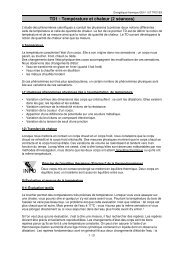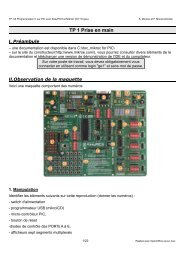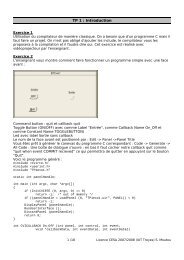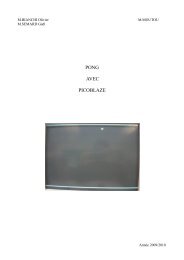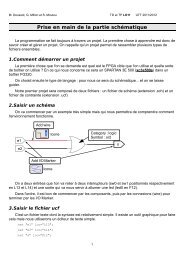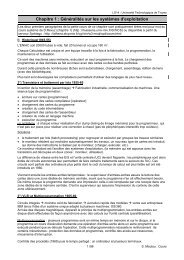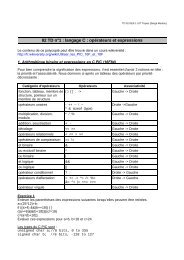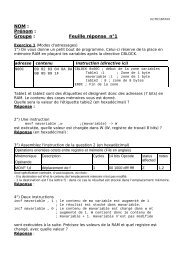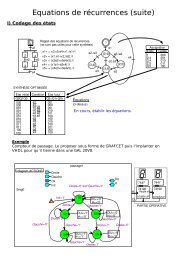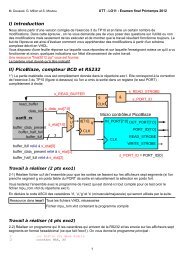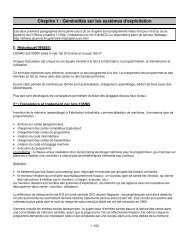Corrections TD2 - exo 3 TD3 - exo 1
Corrections TD2 - exo 3 TD3 - exo 1
Corrections TD2 - exo 3 TD3 - exo 1
Create successful ePaper yourself
Turn your PDF publications into a flip-book with our unique Google optimized e-Paper software.
En C (CCS)<br />
///////////////////////////////////////////////////////////////////////<br />
//// EX_STWT.C ////<br />
//// ////<br />
//// This program uses the RTCC (timer0) and interrupts to keep a ////<br />
//// real time seconds counter. A simple stop watch function is ////<br />
//// then implemented. ////<br />
//// ////<br />
//// Configure the CCS prototype card as follows: ////<br />
//// Insert jumpers from: 11 to 17 and 12 to 18. ////<br />
///////////////////////////////////////////////////////////////////////<br />
#include<br />
#fuses HS,NOLVP,NOWDT,PUT<br />
#use delay(clock=20000000)<br />
#use rs232(baud=9600,xmit=PIN_C6,rcv=PIN_C7)<br />
#define high_start 76<br />
byte seconds, high_count;<br />
#INT_RTCC<br />
//Interrupt procedure<br />
clock_isr() {<br />
//called every time RTCC<br />
high_count -= 1; //flips from 255 to 0<br />
}<br />
if(high_count==0) {<br />
++seconds;<br />
high_count=high_start;<br />
//Inc SECONDS counter every<br />
} //76 times to keep time<br />
void main() {<br />
byte start, time;<br />
//A simple stopwatch program<br />
high_count = high_start;<br />
setup_timer_0( RTCC_INTERNAL | RTCC_DIV_256 );<br />
set_timer0(0);<br />
enable_interrupts(INT_RTCC);<br />
enable_interrupts(GLOBAL);<br />
}<br />
do {<br />
printf("Press any key to begin.nr");<br />
getc();<br />
start = seconds;<br />
printf("Press any key to stop.rn");<br />
getc();<br />
time = seconds - start;<br />
printf("%U seconds.nr", time);<br />
} while (TRUE);<br />
3°) /8 : donne 500000/2048 = 244,140625 passages. On initialise à 244 et l'on aura<br />
donc en une minute, 60000000/999424 = 60,034 allumages.<br />
4°) 1000000μs => 1000000/(256*256*7*2) = 1,089913504μs<br />
=> f=1/1,089913504μs = 0,917504 MHz => fquatrz =0,917504 * 4 = 3,670016 MHz<br />
Le mieux est d'utiliser 1 quartz à 4MHz pour le PIC et un à 3,670016 MHz pour PB0 qui<br />
peut être utilisér le PIC et un à 3,670016 MHz pour PB0 qui peut être utilisé



